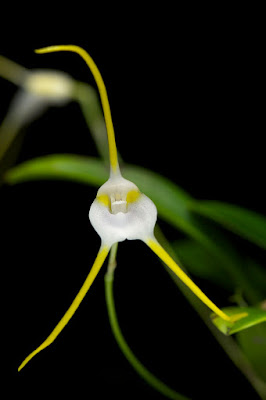Masdevallia mejiana is endemic to Colombia. The original collection data for this species is unknown, but it has subsequently been collected at lower elevations in the northern part of the Western Cordillera of Colombia (500 to 815 m), where it grows in the high branches of tall trees, in considerable sunlight.
Masdevallia mejiana also called as Mejia's Masdevallia, Reichantha mejiana, is a species of the genus Masdevallia. This species was described by Leslie Andrew Garay in 1970. This species is named in honor of Alvaro Mejía of Medellín, Colombia, in whose orchid collection this species was discovered in 1970.
IDENTIFY MASDEVALLIA MEJIANA ORCHID PLANT
Masdevallia mejiana is endemic to Colombia. The original collection data for this species is unknown, but it has subsequently been collected at lower elevations in the northern part of the Western Cordillera of Colombia (500 to 815 m), where it grows in the high branches of tall trees, in considerable sunlight.
It is a mini-miniature sized, warm growing, tufted, epiphyte with slender, erect, ramicauls enveloped basally by 2 to 3 tubular sheaths carrying a single, apical, suberect, fleshy-coriaceous, oblong-lanceolate, obtuse leaf that gradually narrows into the petiole.
Mejia's Masdevallia blooms in the winter with 1 or 2 flowers per ascending, 10 cm long, terete inflorescence arising from low on the ramicaul with a bract above the base and a floral bract holding the campanulate, fragrant flowers at or at mid-leaf height. The solitary (occasionally followed by a second) 10 cm flower are white with faint purplish speckling and a yellow flush where the dorsal and lateral sepals fuse, and with bright yellow tails. The lateral sepals are deeply connate, forming a broad synsepal with descending yellow tails similar to the dorsal sepal.
MASDEVALLIA MEJIANA ORCHID PLANT CARE AND CULTURE
Cultural information should only be used as a guide, and should be to be adapted to suit you. Your physical location; where you grow your plants, how much time you have to devote to their care, and many other factors, will need to be taken into account. Only then can you decide on the cultural methods that best suit you and your plants.
Light:
Masdevallia mejiana like good light, but not direct light. 17000 - 22000 lux is a good amount of light. About 70-90% shade is recommended in summer and 25% shade to full sun in winter. It will flower better if receive plenty of light and leaves are pale green rather than dark green when in heavy shade.
Temperature:
Mejia's Masdevallia should be grown with intermediate to warm growing conditions (13°C at nights, maximum at 26°C days). The temperatures consistently above 30°C will weaken the plants and they may drop their leaves. Ensure 6-12°C day/night difference to aid flower formation.
Humidity:
This orchid prefer high humidity in summer near 75-80% and may need a humidifier over summer. Keep air circulation at all times to prevent water staying on leaves as this will encourage leaf spot.
Substrate, growing media and repotting:
Masdevallia mejiana can be grown in basket or net pots. They can also be grown in pots or mounted. They prefer a continuously damp medium. Some growers use chopped sphagnum moss mixed with polystyrene chips. Others use a pine bark, polystyrene and coarse perlite mix. A mix of 5 parts bark, 5 parts perlite and 1 part fibrous, not fine, peat moss is recommended. Their roots are small and many and will fill pots very quickly when growing well. Deeper pots are generally used and plants are potted out from being divided into 5cm tubes, 7-10cm pots or 12-15cm pots depending on size.
Repot or divide the plants during the autumn or spring every two years or when they are sufficiently large enough. It is best, as with most plants, to repot when the plants are about to root to minimize disturbance. Huge clumps must be divided as a considerable number of species tend to completely rot from the oldest parts of the clump. Do not bury the base of the plants. Double potting is beneficial to keep the plant roots cool.
Watering:
Mejia's Masdevallia will not tolerate dry conditions and should be kept moist but not soggy. Their roots must be able to dry out slightly between waterings. In hot weather they need daily watering but in spring and autumn weekly watering should suffice. Water in the morning so leaves can be dry by midday. The plants should be provided with rain water or distilled water or a very pure water source. It is preferable to provide a humid environment than keeping roots too wet as they are prone to rotting.
Fertilizer:
Masdevallia mejiana are generally active throughout the year although growth may be slower in winter. Use a balanced fertiliser at 1/4 strength throughout the year; feed at every third or fourth watering. If in doubt do not feed. These plants do not like salt so roots will easily turn brown if over fed. If plants need a boost then a dilute foliar feed can be applied. Higher feeding schedules can be used if the grower masters their culture perfectly well. Do not use lime or dolomite lime.















COMMENTS